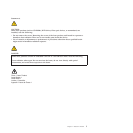The memory bus supports up to 24 GB of memory when registered DIMMs are installed. The server
supports up to 8 GB if unbuffered DIMMs are installed. The memory controller supports error
correcting code (ECC) for up to six industry-standard PC3-8500 or PC3-10600R-999, 1066 and 1333
MHz, DDR3 (third-generation double-data-rate), registered or unbuffered, synchronous dynamic
random access memory (SDRAM) dual inline memory modules (DIMMs).
v Integrated network support
The server comes with an integrated Intel Gigabit Ethernet controller, which supports connection to a
10 Mbps, 100 Mbps, or 1000 Mbps network. For more information, see “Configuring the Gigabit
Ethernet controllers” on page 219.
v Integrated Trust Platform Module
This integrated security chip performs cryptographic functions and stores private and public secure
keys. It provides the hardware support for the Trusted Computing Group (TCG) specification.
v Large data-storage capacity and hot-swap capability
The server supports a maximum of four 2.5-inch hot-swap Serial Attached SCSI (SAS) hard disk drives,
two 3.5-inch simple-swap Serial ATA (SATA) hard disk drives, or two 3.5-inch hot-swap SAS or SATA
hard disk drives, depending on the server model.
With the hot-swap feature, you can add, remove, or replace hard disk drives without turning off the
server.
v PCI card capabilities
The server has two PCI interface slots (one supports low-profile cards and one supports half-length,
full-height cards). Both slots can support PCI Express PCI cards.
v RAID support
The RAID controller provides hardware redundant array of independent disks (RAID) support. The
standard RAID controller provides RAID levels 0, 1, and 1E. Optional RAID PCI cards are available for
purchase that provide additional RAID levels.
v Systems-management capabilities
The server comes with an Integrated Management Module (IMM). When the IMM is used with the
systems-management software that comes with the server, you can manage the functions of the server
locally and remotely. The IMM also provides system monitoring, event recording, and network alert
capability. The systems-management connector provides additional security by physically separating
the management network traffic from the production network. You can use the Setup Utility to
configure the server to use a dedicated systems-management network or a shared network.
v TCP/IP offload engine (TOE) support
The Ethernet controllers in the server support TOE, which is a technology that offloads the TCP/IP
flow from the microprocessor and I/O subsystem to increase the speed of the TCP/IP flow. When an
operating system that supports TOE is running on the server and TOE is enabled, the server supports
TOE operation. See the operating-system documentation for information about enabling TOE.
Note: The Linux operating system does not support TOE.
v Preboot diagnostics program
The preboot diagnostics programs are stored on the integrated USB memory. They collect and analyze
system information to aid in diagnosing server problems. The diagnostic programs collect the following
information about the server:
– System configuration
– Network interfaces and settings
– Installed hardware
– Service processor status and configuration
– Vital product data, firmware, and UEFI (formerly called BIOS) configuration
– Hard disk drive health
– RAID controller configuration
10 ThinkServer ThinkServer RS210, Types 6531, 6532, 6533, and 6534: Hardware Maintenance Manual


















